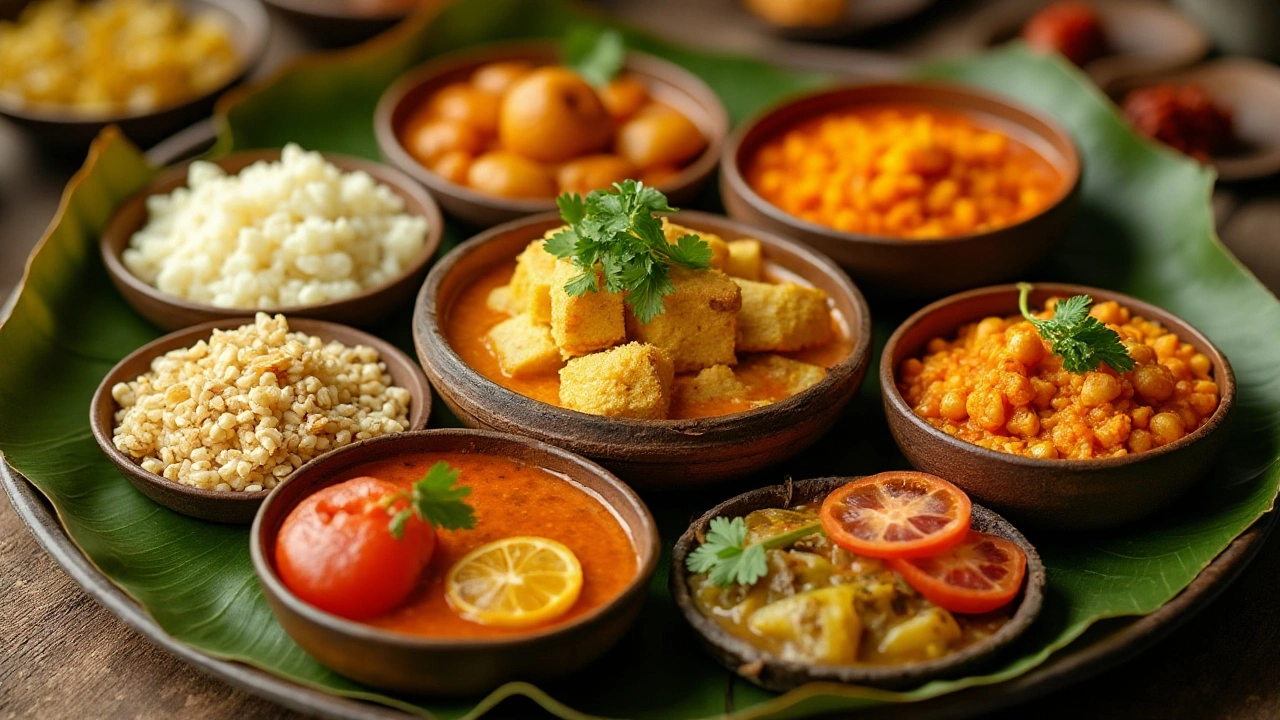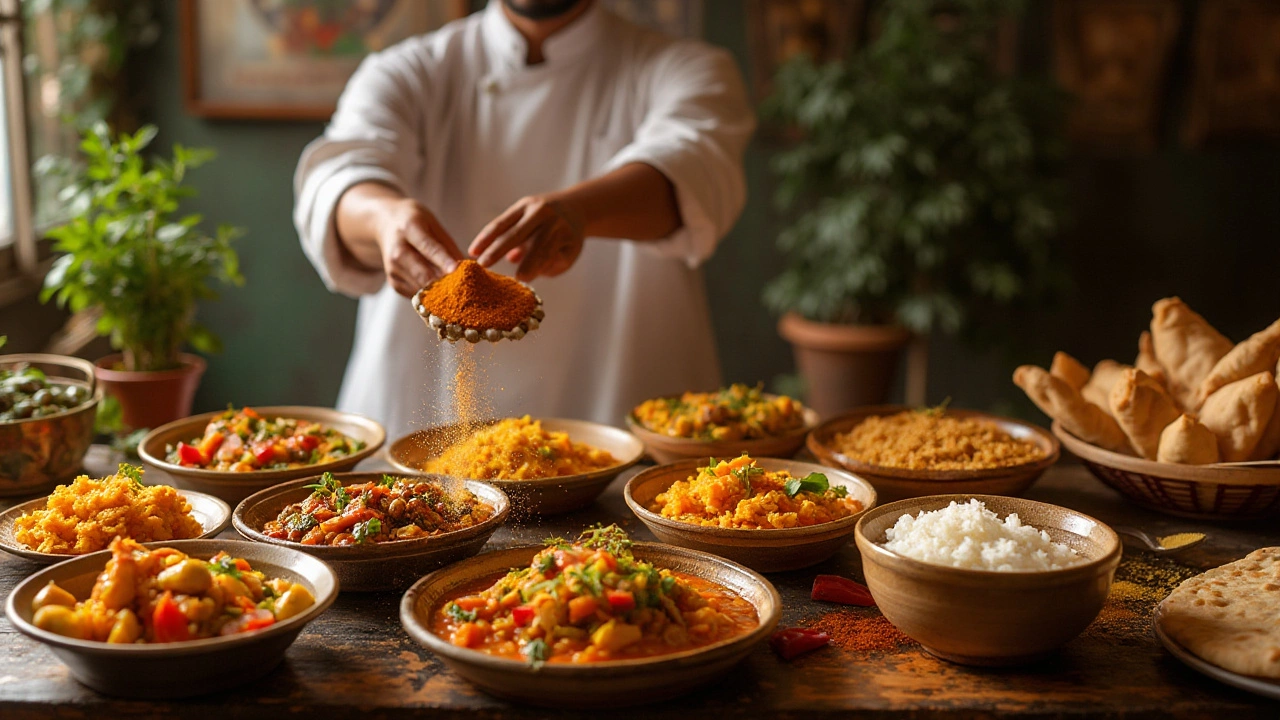25 Dec 2024
- 0 Comments
Indian vegetarian cuisine is celebrated not just for its vibrant flavors, but also for its potential health benefits. With a culinary tradition deeply rooted in the use of fresh vegetables, legumes, and whole grains, it brings together nutrition and taste in a delightful harmony.
At the heart of these dishes are ingredients like lentils, chickpeas, and an array of leafy greens, all of which pack a hefty nutritional punch. Spices such as turmeric, cumin, and coriander are not just for flavor; they are revered for their medicinal properties. These elements combined hint at why these dishes are adored by vegetarians and non-vegetarians alike.
Whether you are a seasoned aficionado of Indian cuisine or someone curious about incorporating more plant-based meals into your diet, it is intriguing to explore how these ingredients and methods come together to create not only satisfying meals but also ones that can support a healthy lifestyle.
- Nutritional Value of Key Ingredients
- Traditional Cooking Methods
- Health Benefits of Common Spices
- Tips for a Balanced Vegetarian Indian Diet
Nutritional Value of Key Ingredients
The heart of Indian vegetarian food lies in its rich tapestry of ingredients, each offering a wide spectrum of health benefits. Central to these dishes are legumes like chickpeas and lentils, known for being high in protein and fiber, which are essential for muscle health and digestion. These plant-based proteins are crucial for vegetarians, who might otherwise struggle to meet their protein needs. Not only do these legumes provide essential amino acids, but they also contribute to maintaining lower blood sugar levels, making them a staple for a balanced diet.
Whole grains such as millets, brown rice, and whole wheat are integral components of Indian cuisine. They serve as the basis for many traditional dishes, from breads like roti to rice-based meals, offering complex carbohydrates which provide sustained energy release compared to their refined counterparts. These grains are loaded with vitamins and minerals, including iron, magnesium, and B-vitamins, supporting everything from bone health to robust brain function. A fascinating fact is the resurgence of millets, recognized as a superfood for their high nutrient content and adaptability to various climates.
A colorful array of vegetables makes Indian vegetarian dishes not only appealing to the eyes but also a powerhouse of vitamins and antioxidants. Ingredients such as spinach, cauliflower, and bell peppers are rich in vitamins A and C, which are important for maintaining healthy skin and boosting immunity. Fresh tomatoes are often a staple in many recipes, offering lycopene, which has been associated with reduced risk of heart disease. The use of seasonal vegetables helps in retaining maximum nutrients and flavor, aligning with sustainable cooking practices.
Spices are not just flavor enhancers in Indian cooking; they are revered for their medicinal properties. For example, turmeric, sometimes called 'golden spice,' is rich in curcumin, known for its anti-inflammatory effects and ability to improve brain function. Similarly, cumin is high in iron, offering a substantial boost to those struggling with iron deficiency. Integrating these spices into daily meals is an easy way to incorporate their health benefits seamlessly. As nutritionist Rujuta Diwekar notes,
"The use of spices like turmeric and cumin in Indian cooking is no mere happenstance catering to the palate but has profound health effects that modern science continues to uncover."
Finally, dairy products such as yogurt and paneer play a significant role in many vegetarian Indian dishes, providing calcium and probiotics that aid in digestion and strengthen bones. Especially in a culture where plant-based foods dominate, these dairy constituents ensure classic taste and nutritional completeness, making Indian vegetarian cuisine both delicious and healthy. Understanding the holistic nature of these ingredients helps us appreciate not just their taste but also their profound health benefits.

Traditional Cooking Methods
The art of Indian cooking has evolved over centuries, blending a medley of cooking methods that enhance the flavors and nutrition of its vegetarian fare. Each method has its own role in bringing out the best in the ingredients, whether it's the subtle fragrance of dry roasting or the rich, layered flavors achieved through slow simmering. Indians have mastered the technique of balancing spices and textures to create dishes that not only satisfy the palate but also nourish the body.
Slow Cooking and Simmering
One of the traditional methods employed in Indian vegetarian food preparation is slow cooking. This method entails simmering food at low temperatures for extended periods, allowing the ingredients to meld beautifully. In addition to enhancing flavors, slow cooking helps in retaining the nutritional content of vegetables. For example, in dishes like 'Rajma'—a spiced kidney bean stew—the slow simmering process ensures that the beans absorb the aromatic spices thoroughly. By balancing the heat and time, this method preserves essential nutrients and brings a delightful depth of flavor.
Dry Roasting
Another vital technique is dry roasting, especially when it comes to spices. This involves heating spices on a skillet or pan without any oil, releasing essential oils that lead to a more profound, aromatic profile. Dry roasting enhances the flavor of spices like cumin and mustard seeds, making them indispensable in lentil dishes and soups. This method, combined with grinding, often forms the base of what is known as 'masala.' It’s through such careful preparation that Indian cuisine achieves its characteristic complex taste. An expert chef once said,
"The magic of Indian food lies in its spices, and how gently heating them can transform a dish."
Steaming and Frying
Steaming, a method used for cooking items like 'Idlis' and 'Dhoklas,' allows the retention of vitamins and minerals while achieving a light, fluffy texture. Unlike other cooking methods that may require a significant amount of oil, steaming relies on moisture, offering a healthy cooking alternative. On the flip side, frying does play a role in Indian cuisine, often used sparingly to add texture in dishes like 'Bhindi Fry' or 'Puri.' However, the focus on balance ensures that even when frying is involved, it contributes to the texture without overpowering the health benefits inherent in the base ingredients.
Baking and Grilling
Although less traditional, baking and grilling are gaining popularity, adapting to modern, health-conscious trends without losing the essence of classic recipes. Grilling vegetables like eggplants and peppers can bring a smoky flavor that's cherished in vegetarian dishes such as 'Baingan Bharta.' Baking is another method that ensures the retention of nutrients while reducing the need for excessive oils, as seen in dishes like 'Naan' and 'Parathas.'
Each of these methods has been tried and tested over time, contributing significantly to the appealing nature of Indian vegetarian dishes. As more people around the world embrace these wholesome cooking techniques, they discover not just the health benefits but the cultural heritage that each dish carries within its layers.

Health Benefits of Common Spices
Indian cuisine is renowned for its rich use of spices, each possessing unique flavor profiles and health-promoting properties. Among these, turmeric stands out for its anti-inflammatory and antioxidant benefits. The active compound curcumin is what lends turmeric its health-enhancing qualities, making it a key player in pain relief and chronic disease prevention. Studies indicate that populations consuming turmeric regularly have lower rates of inflammatory diseases, underscoring its role in maintaining joint health and reducing the risk of heart disease. Incorporating turmeric into your diet is as simple as adding it to soups, stews, or rice, where it not only colors but enriches the nutritional value of dishes.
Another spice that holds a prominent place in the pantry is cumin. Known for its earthy aroma and slightly bitter taste, cumin is more than just a flavor enhancer. It aids digestion by stimulating enzyme secretion from the pancreas, which aids in nutrient absorption and digestion. Cumin seeds have also been linked to improved blood circulation, helping in lowering blood sugar levels and providing a boost to the immune system. Its regular use can be particularly beneficial for those managing conditions like diabetes and high cholesterol.
Cumin has a long history of use in traditional medicine and as a household remedy for digestive issues worldwide.
Among the array of spices that add a burst of flavor and health benefits is coriander. Known for its fresh, citrusy undertones, coriander seeds and leaves are commonly used in Indian dishes. Coriander is rich in immune-boosting antioxidants and has been shown to lower blood sugar levels, improve heart health, protect the skin, and fight infections. It’s these numerous benefits that make it an advisable addition to any meal, be it as a garnish or a core ingredient. Coriander also contains anti-inflammatory properties, making it beneficial for people with arthritis or other inflammatory conditions. Incorporating it in your daily meals is an easy step towards a healthier lifestyle.
Bold in both flavor and health benefits, cardamom is a staple in many Indian recipes. This aromatic spice is lauded for its ability to freshen breath and support digestive health. Studies have also found cardamom to help lower blood pressure, primarily due to its antioxidant and diuretic properties. It’s a versatile ingredient that can be used in both sweet and savory dishes, providing a boost to the metabolism and enhancing respiratory health. Consuming cardamom can help in controlling blood sugar, making it a beneficial addition to the diet of those with diabetes. As these flavors mingle, they create not just a delightful aroma but also nurture the body.
Each of these spices brings its unique healing qualities to the table while transforming ordinary meals into exotic culinary experiences. Their integration in Indian vegetarian dishes does far more than delight the senses. Regular consumption can help in boosting immunity, improving metabolism, and contributing to the overall well-being of those who enjoy them. It’s a testament to the wisdom of ancient culinary practices that understood the healing potential of herbs and spices, which remain relevant in today’s dietary habits.

Tips for a Balanced Vegetarian Indian Diet
Embarking on a journey with Indian vegetarian food means immersing yourself in a tapestry of rich flavors and health-conscious choices. While enjoying the exquisite taste is central, ensuring a well-rounded diet is just as crucial. The first step is to recognize the diverse nutritional profile of various Indian vegetables and legumes that form the core of this cuisine. Lentils, or ‘daals’, are not just protein powerhouses but also a great source of fiber and essential nutrients. Including a variety of these in your diet helps in maintaining digestive health and provides ample energy to go through the day. Legumes like chickpeas, black beans, and kidney beans also offer proteins and other vital nutrients, making them essential staples in any balanced vegetarian regimen.
A key practice in Indian vegetarian cooking is the preparation of colorful mixed vegetable dishes. These dishes, commonly known as ‘sabjis’, combine carrots, peas, bell peppers, and gourds, often seasoned with a host of spices like turmeric and cumin. Such a mix not only satisfies your palate with a burst of flavors but also ensures you are consuming a range of vitamins and minerals. It is crucial to incorporate a rainbow of vegetables on your plate to benefit from the wide spectrum of nutrients they offer. Rotating vegetables in your meals will prevent monotony, encouraging both your interest and overall health.
Maintaining a balanced diet also involves being mindful of the oils and fats used in cooking. Instead of relying on excessive oil, traditional meals often use techniques like steaming, grilling, or sautéing—methods that preserve the integrity of the nutrients in your food. Utilizing healthy oils, like mustard or coconut oil, and ghee in moderation helps maintain healthier cholesterol levels while enhancing the taste of your dishes.
Spices used in Indian dishes aren't just for tantalizing the taste buds; they also come with health perks. Turmeric is known for its anti-inflammatory properties, while cumin aids digestion. As Indian kitchens have known for centuries, these spices not only make meals delicious but can also offer protection against various ailments. Incorporating a mixture of these spices into your diet can fortify your immune system and provide additional health benefits.
To add variation and satisfaction, consider exploring fermented foods like dosas and idlis, which include fermented rice and lentils, acting as natural probiotics promoting gut health. Balancing these with fresh fruits like mangos or pomegranates can invigorate your diet with essential antioxidants.
It's also important to manage portion sizes to prevent overeating, as dishes can be as rich as they are tasty. Preparing meals with an array of starches, proteins, and fibers but ensuring sensible portions will let you enjoy the flavors without excessive calorie intake. As Mahatma Gandhi famously said, "There is more to life than increasing its speed." This wisdom can be equally applied to savoring meals mindfully—a practice that nurtures the body and soul. With these considerations, embracing a balanced vegetarian Indian diet can lead not just to better health, but also to an enriched dining experience.
